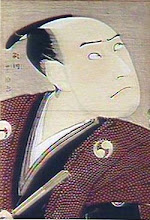Having said that, the one thing I do miss from the 50s is the uniforms hospital workers wore. When I go to the hospital now everyone is either wearing scrubs, those bizarrely patterned polyester tunic outfits, or a lab coat. You don't know if the person coming into your room is a nurse, doctor, therapist, HMO spy or from housekeeping. The only thing you have to identify them, besides their word, is their name tag and the females usually wear theirs backwards so you can't see them. I guess to keep the wrong people from learning their name.
It weren't that way in my day.
Everybody had a uniform, and you knew immediately what that person was allowed to do to you by how they were dressed. That can be very comforting to a young kid.
At the University of Michigan Hospitals they were:
- Housekeeping: Males had a tan V-necked shirt and tan pants.
- Housekeeping: Females wore a yellow dress.
- Porters: (They took things, including patients, places.) A green V-necked shirt and tan pants. They were always male.
- Orderlies: (Kind of a male nurse's or therapist's aide except they did more lifting.) Blue V-necked shirt and tan pants.
- Nurse's Aide: A bright yellow dress.
- Practical Nurse: (LPN) White uniform (dress), stockings and shoes. Her cap had a gray stripe.
- Student Nurse: A blue and white pin-striped uniform (dress) with white stockings and shoes. I don't know what a male student would have worn. I never saw one until after the uniforms were abolished. Their cap told you what year student they were. Sophomores' caps were plain white; juniors' had a thin black stripe; and seniors' had a wide black stripe.
- RNs: Male (Until the late 60s I only knew of one in the whole hospital. He mostly worked on the male orthopedic surgery ward.) White uniform shirt, pants, belt and shoes.
- RNs: Females wore a white uniform with white cap, stockings and shoes. I know they were unhygienic as hell, but I loved the caps. Each nursing school had its own cap design and the only things they had in common were that they were white and had some kind of black ribbon. It was a bit like bird watching. (The pun was unintended, but I'll accept it.) I got pretty good at being able to identify most of the schools in the Michigan, Ohio, Indiana regions, and even knew a few Illinois, New York and Pennsylvania schools.
- 3rd Year Med Students: They wore dress clothes (dress shirt, tie, slacks for men; comparable dress or skirt and blouse for women) with a white sport coat styled jacket. They were also pretty adept at keeping a stethoscope, and anything else medical they could find, draped around their neck.
- Interns: White shirt, white pants, white shoes along with the white sport coat. They could however pick out their own tie. One, a Dr Reinarz by name, opted for the Ben Casey Tunic, complete with top three buttons undone, but he had other issues too. Women, of course, wore a white skirt, but they could also wear a regular blouse under the jacket, and natural colored stockings.
- 1st Year Residents: (Not to be confused with the glorified interns they call 1st year residents these days.) Back to street dress clothes, but with a three quarter length lab coat, and less insistence on the casually draped stethoscope.
- 2nd and 3rd Year Residents: Basically the same, except less insistence on the casually draped stethoscope. The coat could also get a tad longer as long as it clearly wasn't knee length.
- House Doctors: They wore the knee length lab coats.
- Department Head: Their coat went to about mid-calf.










Wow. What a memory! You've got to write this into a story or a book...or a memoir. "Missing factor" is a great title. Do it!
ReplyDeleteI have a pile of old typewritten pages, and even more computer files for something I've been calling "Bed Thirty-six and a half." It was the space where the laundry cart usually was kept, but when there was too many of us they would put a bed there and the cart in the hall. (They didn't know about the Japanese method of just telling the overflow, "Better luck next time.") I liked it because it was on the right just as you entered the ward, and human nature being what it is, fewer people stared at you when they came in because their attention was usually taken up with the bed on the left. (For some reason people tend to look to the left when entering a large room, or so I've been told.)
ReplyDelete